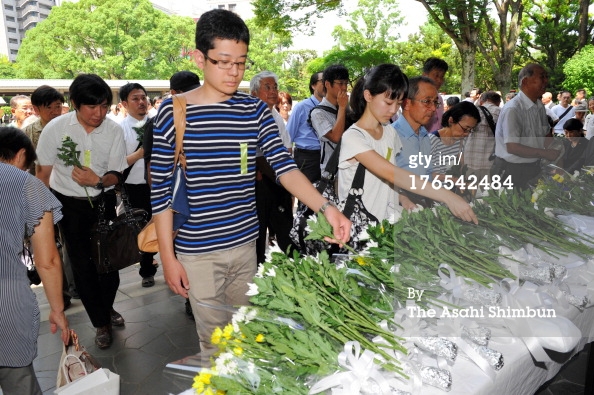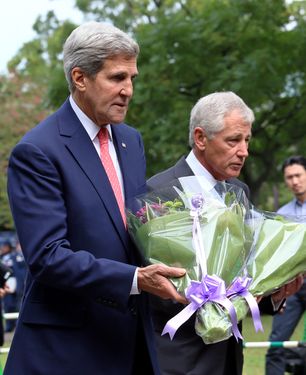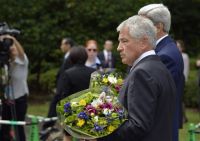
People pay respects at Chidorigafuchi cemetery (courtesy Getty Images)
Lost among the news of the transfer of Amaterasu to her newly built shrine at Ise was an item by Associated Press of the visit of two prominent American government representatives to Chidorigafuchi. The cemetery offers a more neutral and less contentious space than the politically charged Yasukuni Shrine, and the American initiative shows how easy it would be to reach a compromise on the issue. Sadly however it appears that far from compromising, the Abe-led Japanese government is set on military expansionism. Plans are afoot to ditch the anti-war clause in the constitution, and anyone opposed to this can find a petition to sign at https://secure.avaaz.org/en/save_our_peace_constitution_a/?djgzuab
*********************************************************************************
Kerry, Hagel lay wreath at Japan’s national cemetery
Japan Today OCT. 03, 2013 AP
U.S. Secretary of State John Kerry and Defense Secretary Chuck Hagel on Thursday became the most senior foreign dignitaries to pay their respects at Chidorigafuchi National Cemetery near Tokyo’s Imperial Palace, since the Argentinian president in 1979. A cemetery official told AFP the visit had been instigated by the U.S. and had not come about as a result of a Japanese invitation.
U.S. defense officials said the cemetery was Japan’s “closest equivalent” to Arlington National Cemetery. That view contradicts hawkish Prime Minister Shinzo Abe, who has likened Yasukuni shrine, where 14 “Class A” war criminals are among the 2.5 million enshrined, to the U.S. national cemetery in Virginia.
During a visit to the U.S. in May, he told Foreign Affairs magazine that the shrine, seen throughout East Asia as a symbol of Japan’s militarism, was a tribute to those “who lost their lives in the service of their country.” “I think it’s quite natural for a Japanese leader to offer prayer for those who sacrificed their lives for their country, and I think this is no different from what other world leaders do,” he said.
Abe, who was also prime minister from 2006 to 2007, has stayed away from the shrine after China and South Korea angrily denounced predecessor Junichiro Koizumi’s annual pilgrimage. But a growing number of his ministers have visited it. Unlike Arlington, Yasukuni’s caretakers promote a view of history that is controversial even at home, with the accompanying Yushukan museum staunchly defending much of Japan’s wartime record.

Respect for the true equivalent of Arlington: a not so subtle message from US government representatives (AP)
A U.S. official told media Kerry and Hagel were paying tribute at Chidorigafuchi in the same way that “Japanese defense ministers regularly lay wreaths at Arlington”. “This memorial is the closest equivalent. It honors Japanese soldiers, civilians, and support personnel killed on WWII battlefields but whose remains were never recovered by their families. It is a gesture of reconciliation and respect.”
Seki Tomoda, an expert on international politics and diplomacy, said the wreath-laying could be Washington’s attempt to nudge East Asia over the hump caused by the Yasukuni issue, by conferring legitimacy and respectability on Chidorigafuchi. “What’s worrying America most is the fierce row among Japan, South Korea and China over the Yasukuni issue,” he told AFP. “Visiting a more neutral place may be a message from Americans… that they want the three countries to ease their confrontation. Yasukuni, unlike Arlington, is a religious facility… I think it’s impossible that Hagel or any other American leader would visit Yasukuni. Chidorigafuchi was an option (for the U.S.) in order to send a message.”
Chidorigafuchi National Cemetery was built 1959 to house the remains of unidentified Japanese who died overseas during World War II. The Tokyo memorial, maintained by the environment ministry, honors 358,260 dead, mainly soldiers, whose remains have been returned to Japan, but also some civilians who died overseas. The prime minister customarily lays a wreath at the cemetery ahead of the formal Japanese service of remembrance held at a large hall in Tokyo.


I think it is a nice gesture to do this. In the 1950’s film “The Harp of Burma” a former Japanese soldier stays behind in Burma to spend time burying the war dead who had been left to waste away in the jungles and mountains. I’m glad the Secretary of State took part in the ceremony. We should remember our own war dead and even the young men and women who died for the other side. And pray that war doesn’t befall others in the future.